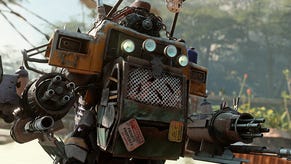All the Rage: An Evening with id Software in Sydney
To celebrate id Software's 20th Birthday, Bethesda booked out the Sydney Opera House. Toby McCasker dusted off the top and tails to hear what creative director Tim Willits had to say.
The time’s 7PM on a brisk, Australian Wednesday evening; the place is Sydney’s own world-renowned architectural fallacy, the Opera House. The guy is id Software creative director, Tim Willits. He’s speaking at length to a cast of hundreds. Some of us are industry pundits. Some of us won a competition and brought our attractive, bewildered girlfriends along for the ride. Most of us are not doing the stereotype any favours. The guy to my left is wearing a brown corduroy jacket and breathing extremely heavily. The guy to my right’s thumbs keep unsettling his lap by compulsively raking the air with Ryu and Ken’s F, D, DF + HP dragon punch movement. At one point, he looks at me helplessly.
Regardless of unenviable dress sense or indentured arcade mannerisms, the unity factor is that we’re all here for one thing. Tim’s hour on stage is as much an affirmation of id’s place in game development history as a confident display of Rage’s many post-apocalyptic charms. The former’s important, not just because it serves as a buffered lead-in to what Rage has to offer, but also because what the giant dot-points behind Tim keep beating everyone over the head with is unequivocally true: id invented the FPS. The team's been tucked away working on Rage since 2007 and it’s been a long time between drinks, so a lot of people could be forgiven for forgetting that fact. Some in attendance never knew it in the first place.
Tim’s hour on stage is as much an affirmation of id’s place in game development history as a confident display of Rage’s many post-apocalyptic charms.
The likes of Wolfenstein 3D, Doom, and Quake did much more for the genre than simply lock you inside a hellbound marine’s skull and give you mondo guns. While many will point to Doom as the genre’s most important development after a certain pixelly hunt for Hitler debuted it, Tim disagrees.
“I believe that Quake was actually more important to our industry than Doom was,” he notes rather controversially.
Not only did id invent the FPS, it also perpetrated much of the theory behind its supporting infrastructure – infrastructure you still enjoy almost twenty years on from Quake. Sure, Doom’s 3D inroads meant you could go up and down, and the BFG was all kinds of cool and excess, but Quake boasted an industry catalyst. At the time of its genesis in ’96, John Romero devised the concept of dedicated servers – and, subsequently, sweet networked multiplayer – amidst no small amount of peer scoffage.
For Tim personally, Quake also served as a very important watershed moment for the then-budding level designer.
“So Quake had this kind of schizophrenic design, and we had a number of these half-levels, these small, little, orphans of levels,” he relates, eyes twinkling.
“I finished all my work on the shareware levels and I said to John Romero and John Carmack, ‘Hey, there are these levels that are kind of cool, but we haven’t finished them. I can finish them, and then we can make deathmatch only levels!’ And both John and John were like: ‘That is the stupidest idea we’ve ever heard.’”
"We can make deathmatch only levels!’ And both John and John were like: ‘That is the stupidest idea we’ve ever heard.'"
There’s a knowing group guffaw and the scribbling in of notebooks: Chalk one more up for id.
“We invented the word ‘deathmatch.’ If we had have trademarked it… we’d be rich!” Tim laments, laughing.
He’s right, id should’ve. Which is why it’s interesting that Rage doesn’t actually have deathmatch. It doesn’t have any kind of adversarial multiplayer. There’s a limited form of two-player co-op, but this is a predominantly single-player FPS. That alone makes it a contemporary anomaly.
Rage also serves as somewhat of a greater metaphor for id itself, as it is now. The very first thing that happens in-game is that you emerge from a long stasis, greeted by the aged corpses of others who were once like you but less dead. Then you stumble, and find your way outside the cold walls of this sterile pod. Instantly, you’re blinded by the light of a plundered and unfamiliar world.
Considering everything Tim’s told us tonight, this moment and this moment alone seems especially poignant. A lot’s changed out there on the wild gaming landscape since the developer pushed out Doom 3 in 2004. The unexplored reaches of first-person gameplay that helped make id a household name in the early ‘90s and beyond now no longer apply.
As influential as it is, the indelible pedigree isn’t supposed to convince you that Rage must be the greatest FPS of all time simply because id made it. Tim prefers demonstration over hyperbole.
“Many people ask me, why a new IP? You have Doom, Quake, and Wolfenstein, why Rage?” he muses, booting up the game on that towering screen behind him.
“When we finished Doom 3, we were looking at all our titles, all our games. We wanted to stay true to the core of the first-person shooter, but we wanted to expand the experience. Rage has a brand new technology, id Tech 5. There are three things that, really, are the highlights of this new technology: megatextures, true cross-platform, and it’s a 60Hz game.”
Megatextures mean that, even though a whole lot of Rage is broken and barren, nothing ever repeats itself along the game’s expansive virtual canvas. ‘True cross-platform’ tech claims that, in theory, it’s built for exactly the same kind of high-speed sin on both console and PC. And the 60Hz, well. That takes care of the high-speed sin. In a nutshell, Rage is pretty, it (hopefully) won’t suffer from consolitis, and it’s slick. Real slick. It also has one girthy narrative shepherding you from quest to quest.
“John Carmack had a famous saying,” Tim related earlier. “He once said, ‘Story in video games is like story in porn: No-one cares.’”
Call of Duty’s makers, some learnt tonight, even purchased the back-end of Quake III’s engine and repurposed it as the ‘CoD Engine.’
At the time we laughed, but we were also chilled by the prospect of an id-brand facsimile of Borderlands. Tim warms our bones once again when he reconvenes on that anecdote and quips: “Yes, John has come around. The story is important!”
But tonight’s Opera House storytelling is drawing to a close. The lights go down on Tim Willits, his brief history of id, and Rage’s slavering mutants. The cheers and applause aren’t wild, but they are respectful. Some of them are even awed, younger minds still trying to comprehend the gravity of all this stuff they never might’ve known laid the foundations for every marathon Call of Duty session they’ve ever had. Call of Duty’s makers, they learnt tonight, even purchased the back-end of Quake III’s engine and repurposed it as the ‘CoD Engine.’
“Doom was the father of first-person shooters,” Tim farewells. “Quake was the father of awesomeness, and I think Rage… is the new awesomeness.”
Rage releases for PC, PlayStation 3 and Xbox 360 next week.









